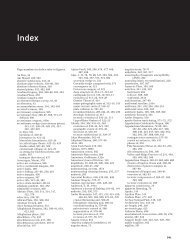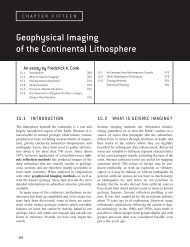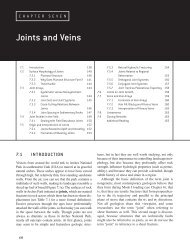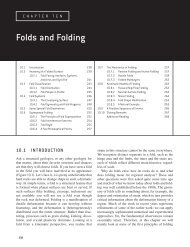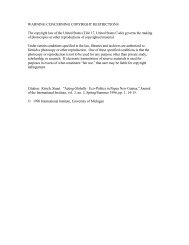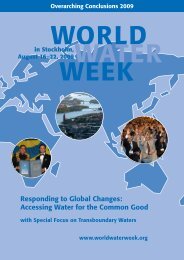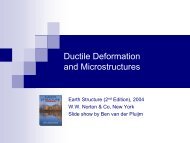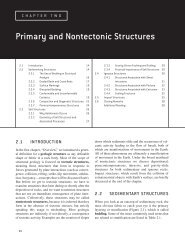The formation of an orocline by multiphase ... - ResearchGate
The formation of an orocline by multiphase ... - ResearchGate
The formation of an orocline by multiphase ... - ResearchGate
Create successful ePaper yourself
Turn your PDF publications into a flip-book with our unique Google optimized e-Paper software.
A.B. Weil et al. / Journal <strong>of</strong> Structural Geology 22 (2000) 735±756 747Table 2 (continued )Site Number In Situ Bedding Tectonic Correction Tectonically CorrectedStrike Inv. Dip Dip Fold Axis Trend Fold Axis Plunge Rotation Dec Inc Strike DipSL78 bd 27 115 65 62 34 43 148 2 346 101SL79 be 50 100 80 60 45 32 155 8 347 94SL80 210 74 210 0 56 139 5 210 15SL81 332 70 332 0 60 146 5 332 14SL82 113 51 45 50 51 146 22 130 59a H Ð High temperature component.b Designates overturned bedding.c First rotated with B magnetization as stated in text <strong>an</strong>d shown in Table 3.d First rotated about a vertical axis 288.e First rotated about a vertical axis 508.From the above results we use the previously determinedB magnetization direction (V<strong>an</strong> der Voo et al.,1997) as a reference for the in-situ low temperaturecomponents, <strong>an</strong>d the C magnetization direction as areference for the in-situ high temperature components.By iterating the di€erent possible fold geometries thatwould result in both the La Vega de los Viejos's present-daybedding attitudes (Fig. 9b) <strong>an</strong>d its in-situmagnetic direction scatter (Fig. 9a), <strong>an</strong> optimum set <strong>of</strong>fold-axes c<strong>an</strong> be determined (Fig. 9c <strong>an</strong>d e).Two fold-axes were calculated to bring all low temperature(B) magnetic vectors into coincidence: <strong>an</strong>orthern axis that accommodates sites SL64, SL69,PL55, <strong>an</strong>d PL56, <strong>an</strong>d a southern axis that accommodatessites SL58, PL51, <strong>an</strong>d PL52 (Fig. 9c). Both rotationaxes have <strong>an</strong> approximately east±westorientation <strong>an</strong>d the amount <strong>of</strong> total rotation requiredis, on average, approximately 258 less th<strong>an</strong> that neededfor the older C component. After correction, thepaleomagnetic site me<strong>an</strong>s cluster around the referenceB direction (Fig. 11a) <strong>an</strong>d the bedding takes on <strong>an</strong>orth±south trend.To correct for the C component we ®rst <strong>an</strong>alyzedthe seven sites that carried stable B <strong>an</strong>d C magnetizations.This allowed the subtraction <strong>of</strong> rotations thatoccurred subsequent to the younger B magnetization(i.e. F 3 folding). <strong>The</strong> additional correction needed tobring the C component into agreement with the referenceC direction corresponds to F 2 folding (Fig. 9d).This additional rotation has a component <strong>of</strong> verticalaxisrotation as seen in the declination scatter, <strong>an</strong>d tiltas seen in the average negative inclination. This secondarycorrection also de®nes the di€erence in kinematicsbetween F 1 <strong>an</strong>d F 2 folding. F 1 folding wasstrictly about near horizontal north±south-trendingfold axes, whereas F 2 was about much steeper axesthat produced further tightening <strong>of</strong> F 1 longitudinalstructures, while at the same time adding a small component<strong>of</strong> vertical-axis rotation. Re-examination <strong>of</strong> theB <strong>an</strong>d C magnetizations <strong>of</strong> the Lagos del Valle Synclineto the east (V<strong>an</strong> der Voo et al., 1997) shows thesame kinematic distinction, which suggests that thedi€erence in rotation is not <strong>an</strong> artifact <strong>of</strong> limited databut a true contrast in folding kinematics between F 1<strong>an</strong>d F 2 folding. As <strong>an</strong> internal check, the two-step rotationmethod was compared to a one-step rotationfor correcting the in-situ C components directly backto the reference C direction (Table 3). <strong>The</strong> axes <strong>of</strong> rotationfor both correction methods had similar orientations<strong>an</strong>d rotation <strong>an</strong>gles, suggesting that there waslittle bias between techniques. <strong>The</strong> remainder <strong>of</strong> the Ccomponent sites that lack adequately determined Bcomponents were, <strong>of</strong> necessity, corrected using only asingle composite rotation.Two fold axes were determined for the remainingsites that carried only the C component magnetic vectors:sites (SL65, SL68, PL53, PL57) from the north,sites (SL61, SL62, SL66, SL67, SL70, SL71, PL54)from the middle <strong>an</strong>d sites (PL49 <strong>an</strong>d PL50) from thesouth (Fig. 9e). Figs. 9(a) <strong>an</strong>d 11(b) show in-situ <strong>an</strong>dtilt-corrected C component site me<strong>an</strong>s, respectively.After applying the same rotations to the in-situ bedding,the La Vega de los Viejos Syncline is restored toits pre-F 2 geometry (bedding <strong>an</strong>d magnetic directioncorrections c<strong>an</strong> be found in Table 2). This correctionresults in a linear north±south-trending syncline(Fig. 11c) similar to the restored La Queta (Fig. 8) <strong>an</strong>dLagos del Valle Synclines to the northeast (V<strong>an</strong> derVoo et al., 1997).4.4. Proza <strong>an</strong>ticlineTwenty-three sites were collected around the ProzaAnticline from the S<strong>an</strong>ta Lucia Formation. Ten siteswere collected from the east limb, <strong>an</strong>d 13 sites fromthe western limb (Fig. 4). Typical orthogonal demagnetizationplots <strong>an</strong>d site me<strong>an</strong>s for the Proza Anticlineare shown in Figs. 5(c) <strong>an</strong>d 12. <strong>The</strong> geologic map pattern<strong>of</strong> the western limb <strong>an</strong>d partially exposed easternlimb are both characterized <strong>by</strong> <strong>an</strong> S-shaped outcrop



